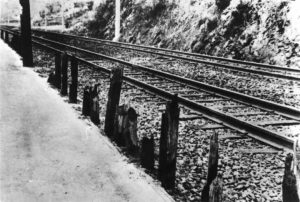Documenting Hiroshima of 1945: End of August, traces of spontaneous combustion brought about by thermal rays
Aug. 28, 2024
by Minami Yamashita, Staff Writer
At the end of August 1945, a charred wooden fence still stood along the Sanyo Line railway tracks in the area of Yamate-cho (in Hiroshima’s present-day Nishi Ward), 2.1 kilometers west of the hypocenter. Based on the conditions at the site, the fire is believed to have broken out spontaneously at the time of the bombing. A photograph taken by Isao Kita, who died in 2001 at the age of 89, reveals the intensity of the thermal rays.
“He was a fanatic about record keeping and a lover of cameras. I think he wanted to leave something behind as an observer,” said his third son, Nobuhiko Kita, 76, who is a resident of Hiroshima’s Asakita Ward. Isao, 34 at the time of the bombing, was chief engineer at the Hiroshima District Meteorological Observatory (present-day Hiroshima Local Meteorological Observatory, in the city’s Naka Ward).
On August 6, he experienced the atomic bombing at the observatory, located on top of Ebayama Hill (in Hiroshima’s present-day Naka Ward). The logbook for that day reads, “Half of the observatory staff were wounded by the blast from the bombing.” Despite the successive absence from work of many of the staff members, Mr. Kita and other colleagues continued their work of observing meteorological conditions. They also conducted their own investigations into the unique damage caused by the atomic bombing. Their survey of spontaneous combustion appeared in the Hiroshima Atomic Bomb Devastation Survey Report (Meteorological Aspects), compiled in 1947.
The report indicated that the fence in Yamate-cho was “confirmed to have clearly ignited and smoldered on its own and did not burn due to the spread of fire.” The report also noted that, within a three-kilometer radius of the hypocenter, dry, flammable materials such as straw-thatched roofs, pine needles in forested areas, and railroad ties were observed to have spontaneously ignited.
The publication of surveys of the atomic bombing was restricted under Japan’s occupation, with the observatory’s report finally published in 1953 based on the efforts of staff to continue keeping records starting shortly after the bombing.
Mr. Kita wrote in a personal account he contributed to a collection of photos concerning the bombing while he was still alive, “With the scenes of the tragedy recorded in this photograph, my hope is that war will never be repeated.” Continuing in September 1945, Mr. Kita took photos of the Aioi Bridge, located near the hypocenter, as well as other locations.
(Originally published on August 28, 2024)
At the end of August 1945, a charred wooden fence still stood along the Sanyo Line railway tracks in the area of Yamate-cho (in Hiroshima’s present-day Nishi Ward), 2.1 kilometers west of the hypocenter. Based on the conditions at the site, the fire is believed to have broken out spontaneously at the time of the bombing. A photograph taken by Isao Kita, who died in 2001 at the age of 89, reveals the intensity of the thermal rays.
“He was a fanatic about record keeping and a lover of cameras. I think he wanted to leave something behind as an observer,” said his third son, Nobuhiko Kita, 76, who is a resident of Hiroshima’s Asakita Ward. Isao, 34 at the time of the bombing, was chief engineer at the Hiroshima District Meteorological Observatory (present-day Hiroshima Local Meteorological Observatory, in the city’s Naka Ward).
On August 6, he experienced the atomic bombing at the observatory, located on top of Ebayama Hill (in Hiroshima’s present-day Naka Ward). The logbook for that day reads, “Half of the observatory staff were wounded by the blast from the bombing.” Despite the successive absence from work of many of the staff members, Mr. Kita and other colleagues continued their work of observing meteorological conditions. They also conducted their own investigations into the unique damage caused by the atomic bombing. Their survey of spontaneous combustion appeared in the Hiroshima Atomic Bomb Devastation Survey Report (Meteorological Aspects), compiled in 1947.
The report indicated that the fence in Yamate-cho was “confirmed to have clearly ignited and smoldered on its own and did not burn due to the spread of fire.” The report also noted that, within a three-kilometer radius of the hypocenter, dry, flammable materials such as straw-thatched roofs, pine needles in forested areas, and railroad ties were observed to have spontaneously ignited.
The publication of surveys of the atomic bombing was restricted under Japan’s occupation, with the observatory’s report finally published in 1953 based on the efforts of staff to continue keeping records starting shortly after the bombing.
Mr. Kita wrote in a personal account he contributed to a collection of photos concerning the bombing while he was still alive, “With the scenes of the tragedy recorded in this photograph, my hope is that war will never be repeated.” Continuing in September 1945, Mr. Kita took photos of the Aioi Bridge, located near the hypocenter, as well as other locations.
(Originally published on August 28, 2024)








